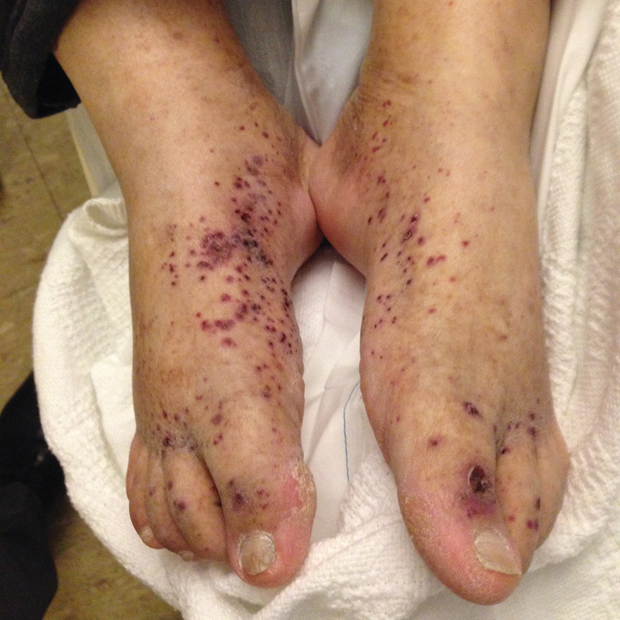MKSAP Quiz: 7-year history of plaques
A 50-year-old man is evaluated in the hospital for fatigue, joint pain, and skin lesions. His symptoms started 2 weeks ago with fever and sore throat, which subsided in 2 days. Fatigue and joint pain were noted 1 day after the onset of sore throat, which worsened over the subsequent days. Four days after the onset of symptoms, he noted dark red spots on his ankles and shins, which spread to involve his legs, thighs, and buttocks; the skin lesions were not painful or itchy. He also notes intermittent central abdominal pain, crampy in nature and not related to food. He has hypertension that was previously well controlled with lisinopril and hydrochlorothiazide.

On physical examination, temperature is 37.8°C (100.0°F), blood pressure is 170/84 mm Hg, pulse rate is 78/min, and respiration rate is 14/min. BMI is 28. Examination of the joints shows tenderness and increased warmth in the knees, ankles, and elbows without effusions. Cardiac and lung examinations are normal. There is mild guarding around the periumbilical area on abdominal examination.
The appearance of the skin is shown.
Laboratory studies:
| Albumin | 3.1 g/dL (31 g/L) |
| Complements | (C3 and C4) Normal |
| Creatinine | 1.8 mg/dL (159 µmol/L) |
| Hepatitis B antibody profile | Negative |
| Hepatitis C antibody profile | Negative |
| Urinalysis | 3+ blood; 2+ protein; 50-100 erythrocytes/hpf; 10-15 leukocytes/hpf; few erythrocyte casts |
| Urine protein-creatinine ratio | 2200 mg/g |
Lupus serologies, antistreptolysin O antibodies, ANCA, and anti–glomerular basement membrane antibodies are pending. Blood cultures are pending. Stool occult blood test is positive.
Which of the following is the most likely diagnosis?
A. Cryoglobulinemic vasculitis
B. Endocarditis
C. IgA vasculitis
D. Systemic lupus erythematosus
Answer and critique
The correct answer is C. IgA vasculitis. This question can be found in MKSAP 17 in the Nephrology section, item 71.
The most likely diagnosis is IgA vasculitis (Henoch-Schönlein purpura). This patient presents with fatigue, joint pain, abdominal pain, petechial/purpural skin lesions, and glomerulonephritis following an upper respiratory tract infection. The differential diagnosis of vasculitis with glomerulonephritis includes infection-related vasculitis (such as endocarditis), cryoglobulinemia, systemic lupus erythematosus, ANCA-associated vasculitis, and IgA vasculitis. Although serologic tests and blood cultures are pending, the patient most likely has IgA vasculitis based on the presence of the tetrad of palpable purpura, arthralgia, abdominal pain, and glomerulonephritis. Although no diagnostic serologic tests for this condition exist, normal complement levels support this diagnosis. Diagnosis is confirmed with biopsy of the affected organ.
Infection-related glomerulonephritis such as endocarditis activates the alternative pathway of complement with low C3 and normal C4 levels. The classical pathway of complement is activated with cryoglobulinemic vasculitis (C4, and sometimes C3, is depressed) and systemic lupus erythematosus (both C3 and C4 are low). In this patient, complement levels are normal, making these diseases less likely. Additionally, cryoglobulinemic vasculitis is associated with hepatitis C virus infection, which is not present in this patient.
Key Point
- IgA vasculitis is associated with abdominal pain, palpable purpura, arthralgia, and glomerulonephritis, with normal complement levels.




